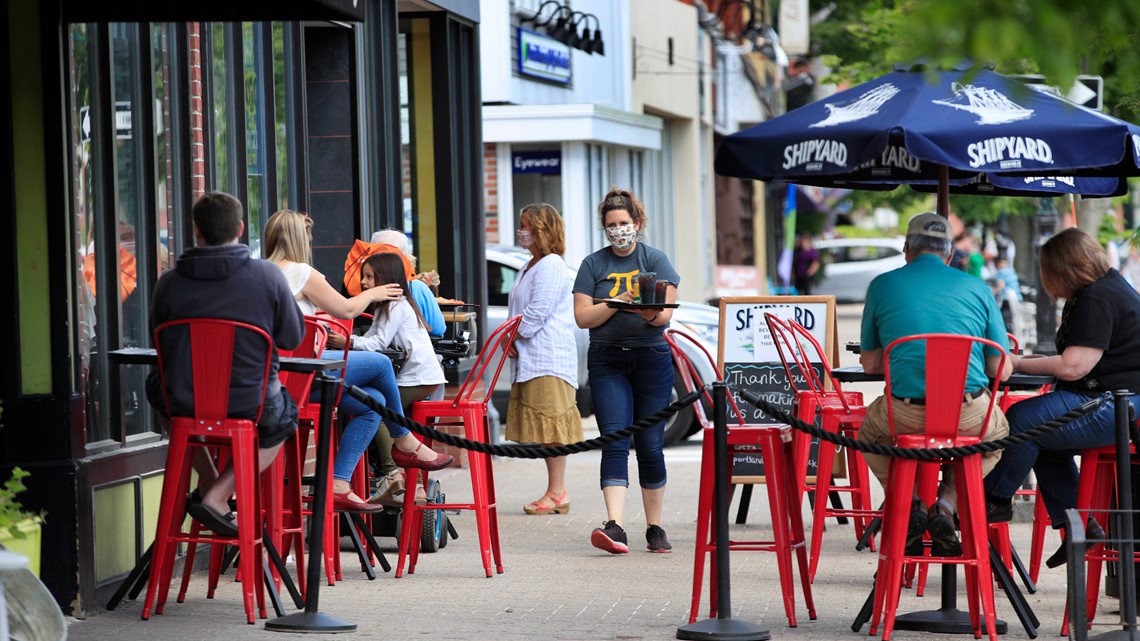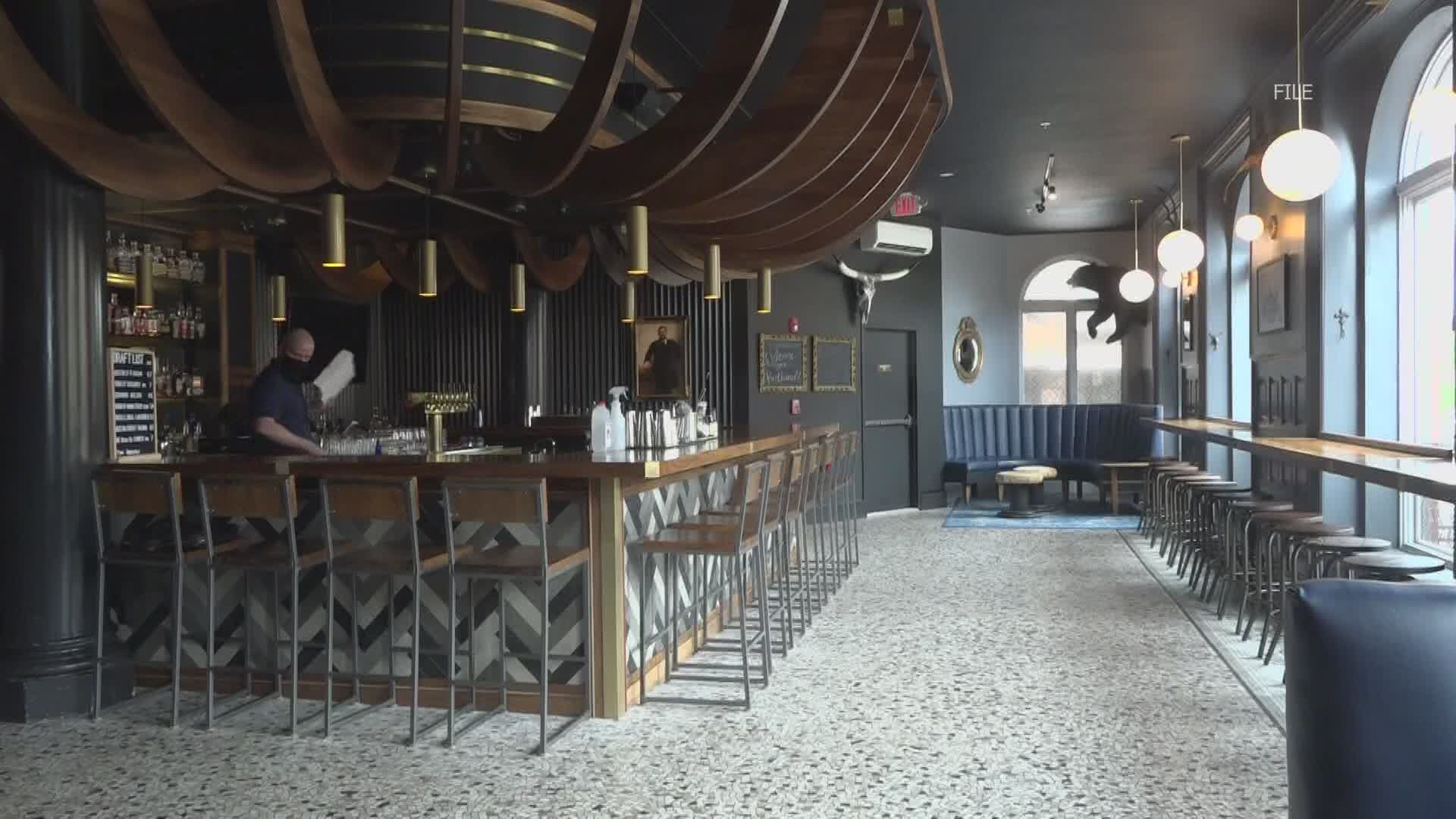MAINE, USA — Gov. Janet Mills made the announcement Monday that more businesses can begin the reopening process in Cumberland, York, and Androscoggin counties starting Wednesday. The acceleration of the reopening plan, which Mills previously delayed for the three counties, puts all 16 Maine counties now back on the same track.
Restaurants in Cumberland, York, and Androscoggin counties can reopen for dine-in service with added health and safety protocols outlined in the COVID-19 Prevention Checklist.
The update also included bars and tasting rooms, which are now allowed to reopen for outdoor dining. Tattoo parlors and nail salons can also reopen, and so can gyms and fitness centers.
There is no requirement for these businesses to reopen. If they are not comfortable, they don't need to open.
But of course, customers and staff members will have to follow strict guidelines from the CDC.
Here’s a breakdown of the updates and what health precautions these businesses must follow.
Restaurants, bars, and tasting rooms
As of June 17, restaurants in all 16 Maine counties will be able to open for dine-in service. Rural counties had been able to offer indoor dining since May 18, and Penobscot County was later added to that list on June 1, the same day Cumberland, Androscoggin, and York counties were able to open for outdoor service only.
Bars and tasting rooms in rural counties could open for outdoor service on June 12, and the recent update says indoor dining in Cumberland, Androscoggin, and York counties can reopen on June 17.


Health and safety precautions outlined by the State for restaurants, bars, and tasting rooms are extensive, but here are some of the key provisions.
- Employees required to wear face coverings; kitchen staff can opt for a face shield
- Frequent hand washing for staff
- Employees' shifts are staggered when possible to avoid overcrowding
- Practice physical distancing with all staff and customers
- Employees trained in proper health practices
- Menus must be laminated
- Restroom occupancy limited
- Minimize exposure by keeping employees on similar shifts
- Tables spaced 6 feet apart
- Bar, kitchen, and dine-in service end at the same time
- Customers should wear face coverings when social distancing is difficult, not required when seated at a table
- Minimize self-service stations like drink stations, salad bars prohibited
- Disposable napkins and table coverings, no cloth linens
- Maximize airflow to increase circulation
- High-touch areas are frequently sanitized
- Hand sanitizer available for customers and staff
- Promote contactless payment options
Click here for the complete COVID-19 prevention checklist for restaurants.
Retail
Retail stores in all counties were able to reopen on June 1.


Some important guidelines for employees and stores include:
- Face covering required, good hygiene, and frequent handwashing
- Practice physical distancing between coworkers and customers
- Discourage usage of using other employees' phones, desks, work stations, and other equipment
- Consider installing plexiglass barriers
- Display procedure signage
- Limit number of customers to 5 customers per 1,000 square feet
- Provide distance markers to encourage distancing
- Regularly clean and disinfect high touch areas
- Promote contactless shopping options like online, self-checkout, curbside pick-up or delivery, and contactless payment options
- Reusable shopping bags are prohibited
- Fitting rooms must be closed
- Consider one-way aisles
- Remove "tester" products
Customers:
- Should wear face coverings
- Don't touch merchandise you don't plan to buy
- Practice social distancing
- Solo shop when possible
Click here for the complete COVID-19 prevention checklist for retail stores.
Gyms and fitness centers


As of June 17, gyms and fitness centers in all counties will be able to reopen. On June 12, just rural counties were able to.
The Mills Administration says health experts recognize the role of exercise in promoting mental health, physical fitness, and cognitive development. Reducing exposure to respiratory droplets through physical distancing and face coverings, as well as increased hand hygiene and avoidance of shared and common touch items, remain the primary tools to mitigate the spread of COVID-19. Because of the increased possibility of infection through droplets, vigorous exercise in closely confined spaces should be avoided.
Some general guidance includes:
- All staff, vendors, and patrons are required to maintain 6 feet of physical distance from individuals who are not part of their household group whenever possible
- Face coverings are required when physical distancing is difficult to maintain. Because staff are in an enclosed space for a prolonged period, it is necessary to wear face coverings at all times even when physically distanced.
- Outdoor gym and fitness activities are encouraged. If an indoor space cannot accommodate the gathering limit without complying with the distancing requirement, attendance must be limited to allow for such compliance.
- Ensure adequate supplies to support healthy hygiene and cleaning procedures
- Improve ventilation
- Modify building traffic to minimize contact
- Stagger sessions if possible
- Restrict use of water fountains
- Locker rooms should be closed except for restrooms
- Showers, saunas, hot tubs should remain closed
- Clean and disinfect bathrooms, equipment, and high-touch areas frequently
- Screen patrons for COVID-19 symptoms
Click here for the complete COVID-19 prevention checklist for gyms and fitness centers.
What's not open (yet)
After Wednesday, June 17, the businesses still not open will include indoor entertainment such as bowling and movie theaters, personal services such as spas and hair removal services. It's also important to note that bars, breweries, and tasting rooms are scheduled to reopen for indoor services on July 1.
Things to consider
While these businesses are reopening, the U.S. CDC is still urging people to carefully consider the health and safety risks before going out. After all, we're still in the midst of a pandemic. In the U.S. there are more than 2 million total cases of COVID-19, and more than 115,000 people have died with the virus. Thousands of new cases are being identified daily as states continue to reopen. Twenty-three states saw case increases over the last 14 days.
And while it’s important to support your local economy and resume some daily activities, it’s also important to make sure you’re safe while doing so.
Click here to read about CDC tips and things to consider before deciding to venture out.
--
At NEWS CENTER Maine, we’re focusing our news coverage on the facts and not the fear around the illness. To see our full coverage, visit our coronavirus section, here: /coronavirus
NEWS CENTER Maine Coronavirus Coverage

